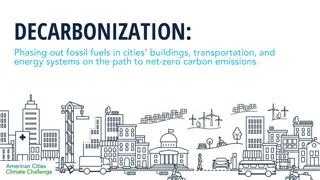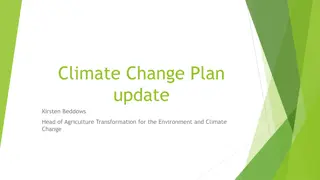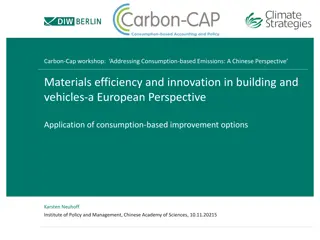Understanding Sustainable Development and Zero Carbon Emissions in Buildings
Sustainable development aims to meet present needs without compromising future generations. Zero carbon emissions in buildings play a crucial role in combating climate change. This article explores the pillars of sustainability, greenhouse gases, global emissions, and steps towards achieving net zero energy buildings.
Download Presentation

Please find below an Image/Link to download the presentation.
The content on the website is provided AS IS for your information and personal use only. It may not be sold, licensed, or shared on other websites without obtaining consent from the author. Download presentation by click this link. If you encounter any issues during the download, it is possible that the publisher has removed the file from their server.
E N D
Presentation Transcript
Zero Carbon Emissions in Building for Sustainable Development Dr. V. Revathi Professor and Head Department of Civil Engineering K.S.R. College of Engineering Tiruchengode.
Content Sustainable development Greenhouse Effect Global Greenhouse Gas Emissions Global Warming Understanding of Carbon Net Zero Carbon How do you make a zero-carbon building? Net Zero Energy Building (NZEB) Steps for NZE Buildings Zero Energy Building Vs Green Building 2
What is sustainable development? Sustainable development is development that meets the needs of the present without compromising the ability of future generations to meet their own needs. The four pillars of sustainability - preservation of a particular resource. Human sustainability aims to maintain and improve the human capital in society. Investments in the health and education systems, access to services, nutrition, knowledge and skills are all programs under the umbrella of human sustainability. Social sustainability aims to preserve social capital by investing and creating services that constitute the framework of our society. Economic sustainability aims to maintain the capital intact. If social sustainability focuses on improving social equality, economic sustainability aims to improve the standard of living. In the context of business, it refers to the efficient use of assets to maintain company profitability over time. Environmental sustainability aims to improve human welfare through the protection of natural capital (e.g. land, air, water, minerals etc.). 3
Greenhouse Effect The main gases responsible for the greenhouse effect - carbon dioxide, methane, nitrous oxide, and fluorinated gases Greenhouse gases cause climate change by trapping heat, and they also contribute to respiratory disease from smog and air pollution. Extreme weather, food supply disruptions, and increased wildfires are other effects of climate change caused by greenhouse gases. Carbon dioxide (CO2) is the primary greenhouse gas emitted through human activities. 4
Global CO2 emission from Fossil Fuel Combustion and Some Industrial Processes 6
Global Carbon-Dioxide Emissions, 18502040 SOURCE Carbon Dioxide Information Analysis Center (Oak Ridge National Laboratory, 2017) World Energy Outlook (International Energy Agency, 2020). 7
Global Warming Global warming is the long-term warming of the planet's overall temperature. Causes Usage of vehicles: Cars and trucks emit gases like Carbon dioxide and nitrogen oxides. Deforestation: When trees are cut, the stored carbon is released into the atmosphere as Carbon dioxide which leads to global warming. Effects Global warming effects ecosystems through temperature rises, water shortages, increased fire threats, drought, weed and pest invasions, intense storm damage and saltwater intrusion 8
Understanding of Carbon Embodied carbon is the carbon dioxide (CO ) emissions created during material extraction, transport to manufacturer, manufacturing, the transport of those materials to the job site, and the construction practices used. It also refers to the CO produced maintaining the building and eventually demolishing it, transporting the waste, and recycling it. Operational carbon is the carbon that comes from energy, heat, lighting, etc. refers to the greenhouse gas emissions due to building energy consumption. 10
Who is the biggest carbon polluter in the world? China, with more than 10,065 million tons of CO2 released. United States, with 5,416 million tons of CO2 India, with 2,654 million tons of CO2 Russia, with 1,711 million tons of CO2 Japan, 1,162 million tons of CO2 Germany, 759 million tons of CO2 Iran, 720 million tons of CO2 South Korea, 659 million tons of CO2 Saudi Arabia, 621 million tons of CO2 Indonesia, 615 million tons of CO2 11
Which countries are carbon negative? The world's smallest nations Bhutan, Suriname and Panama 12
Net Zero Carbon Net Zero Carbon - refers to the balance between the amount of greenhouse gas produced and the amount removed from the atmosphere. Why is net zero important? The science shows clearly that in order to prevent the worst impacts of climate change and preserve a livable planet, global temperature increase needs to be limited to 1.5 C above pre-industrial levels. Currently, the Earth is already about 1.1 C warmer than it was in the late 1800s, and emissions continue to rise. To keep global warming to no more than 1.5 C as called for in the Paris Agreement emissions need to be reduced by 45% by 2030 and reach net zero by 2050. 13
Construction Industry's Race to Net-Zero The built environment accounts for 39% of gross annual carbon emissions worldwide. Embodied emissions is a significant offender. New modes of construction and new ways of tracking data offer a route toward cutting embodied carbon and creating a zero emissions construction industry Any route to net-zero requires clear thinking and thorough accounting, beginning with accurate measurements of all carbon sources in order to ultimately reduce, reuse and recycle wherever possible. 14
Net-zero Target The top seven emitters (China, the United States of America, India, the European Union, Indonesia, the Russian Federation, Brazil) accounted for about half of global greenhouse gas emissions in 2020 More than 70 countries, including the biggest polluters China, the United States, and the European Union have set a net-zero target, covering about 76% of global emissions more than 1000 cities, over 1000 educational institutions, and over 400 financial institutions have joined the Race to Zero, pledging to take rigorous, immediate action to halve global emissions by 2030 15
Net-zero Net-zero (carbon-neutrality) is a balance between the amount of earth-warming greenhouse gas (GHGs) emissions (carbon dioxide, nitrous oxide, methane, etc) produced and the amount eliminated from the atmosphere to tackle climate change. Impact is neutral. Emissions are balanced by efforts to offset them, these include planting trees, changing industrial processes, restoring forests or using nature-friendly technology to store and capture carbon emitted from burning oil and coal. Replacing polluting coal, gas and oil-fired power with energy from renewable sources, such as wind or solar, would dramatically reduce carbon emissions. 16
Net-zero - contd Best Ways to Reduce Air Pollution Use public transports. ... Switch to an electric vehicle. Turn off the lights when not in use. ... Use of fans instead of Air Conditioner. ... Use filters for chimneys. ... Avoid usage of cracker Plant a tree. Recycle and Reuse. ... No to plastic bags. ... Reduction of forest fires and smoking. ... 17
Why Zero Energy Building? To overcome energy crisis Reduce energy consumption Reduce Greenhouse gases and global warming Reduce climatic change Reduce dependence on fossil fuels Protect our environment for future generations 18
What is the principle of zero energy building? A Zero Energy Building (ZEB), also known as a Net Zero Energy (NZE) building, is a building with net zero energy consumption, meaning the total amount of energy used by the building on an annual basis is equal to the amount of renewable energy created on the site or in other definitions by renewable energy sources 19
How do you make a zero-carbon building? Step by step Procedure 1. Passive design optimisation. 2. Reduce operational energy demand and consumption. 3. Eliminate fossil fuels. 4. Provide onsite renewable energy and storage where possible. 5. Limit upfront embodied carbon. 6. Consider whole life carbon in conjunction with whole life costing. 20
1. Passive design optimisation Facade design is key. Utilise the useful daylight index to ensure the best possible daylight for occupants Limit artificial lighting use Reduce glazing areas, glare, heat loss, cooling loads and improving views and occupancy comfort. Enable full or partial natural ventilation for a proportion of the year, supplemented by mechanical systems to provide heat recovery in winter and cooling in summer where required. 21
2. consumption Reduce operational energy demand and Prioritize fabric measures to drive down heating, cooling and lighting demand. Widen temperature set bands and allow occupants to adapt and control their own comfort by adjusting clothing, using fans and natural air flow. Review drivers of energy consumption to determine suitable alternate approaches that can be taken. Challenge conventional design practices and standards, recognising that the same solutions will result in the same energy intensive buildings and looking for alternative solutions. Utilise industry standards approaches like to embed energy savings at every stage and meet best practice energy intensity targets. 22
3. Eliminate fossil fuels Prioritise fifth-generation heat networks and electric heat pump technologies over fossil fuel technologies to supply affordable low carbon energy. When considered in conjunction with zero emission vehicles, this will significantly improve local air quality. 23
4. Provide storage where possible onsite renewable energy and Supply all remaining energy from on-site technologies or off-site renewable certified energy sources. 24
5. Limit upfront embodied carbon Consider all upfront carbon associated with the initial build and restrict carbon intensity to a maximum of 500 kg CO2/m2. This applies to all construction materials from extraction to installation, including the emissions associated with the construction works themselves. Use modular construction approaches, design for deconstruction using circular economy principles, and limit waste generated during construction. 25
6. Consider whole life carbon in conjunction with whole life costing Measure all upfront and operational carbon emissions, including maintenance, fit outs, minor and major refurbishments, deconstruction and the reuse of building materials. All this must be considered over an extended design life allowing for durability and robustness. 26
An example of a zero energy building The Unisphere, Maryland, U.S.A. Spread across an area of 135,000 square feet, The Unisphere stands in the middle of the city in downtown silver spring as a sterling example of technologies embodied, making it a fully sustainable, net-zero energy construction. 27
Zero Energy Building in India Indira Paryavaran Bhawan, New Delhi G+7 storeyed plus 3 basements The new office building for Ministry of Environment and Forest (MoEF) sets is a radical change from a conventional building design. 28
How to make home net zero? Renewable generation. Solar (roof-mounted PV panels) is currently the most affordable way to generate your own energy. Efficient water management. Exceptional air sealing. Smart devices. Continuous insulation. Energy Star appliances. High performance windows and doors. Efficient lighting. 29
Renewable Generation Solar (roof-mounted PV panels) is currently the most affordable way to generate your own energy. A PV system can deliver electricity at 60 to 70% of the cost of electricity you buy from the grid. 31
Efficient Water Management Reduces use of hot water (Low flow water fixtures, stacked plumbing, drain water heat recovery, and on-demand hot water recirculation). 32
Exceptional Air Sealing Air sealing yields the greatest energy savings and improves the overall comfort of your home. Keep in mind that weatherization and proper ventilation go hand in hand. 33
Exceptional Air Sealing Establishes limits to energy usage and reduces energy waste. 34
Continuous Insulation With better insulation, a smaller heating system will do the job, and it will do it more efficiently. You ll spend less money both heating and cooling year-round. 35
Energy Star Appliances Efficiency and durability for all major appliances. 36
High Performance Windows and Doors Replace old, drafty windows and doors with a high-performance, triple- pane brand, or install low emissivity (Low-E) storm windows. Reduces heat loss, provides day lighting, and reduces risk of condensation. 37
Low emissivity storm windows Energy Saver Replacing single-pane windows with double-pane windows that have high-performance glass may be cost effective, but you could also consider installing low emissivity (low-e) storm windows. Installing interior or exterior energy-efficient storm windows that are rated by the Attachment Energy Rating Council (AERC) can produce similar savings but at about 1/3 of the cost. Storm windows can help reduce air movement into and out of existing windows, helping to improve comfort and reduce heating and cooling costs. Interior Storm Window Exterior Storm Window Courtesy Larsen Windows 38
Efficient Lighting Substitute old bulbs with LEDs, room by room or smart bulbs for low energy and high-quality lighting. 39
Heat Pump Efficient electric heating and cooling (air-to-air, air-to-water, Ground source heat pumps (GSHP). 40
Fresh Air System Distributes filtered fresh air throughout the home with high efficiency heat recovery. 41
Heat Pump Water Heater Efficient electric water heating. 42
Home Energy Monitor Optimizes energy use throughout the home. 43
Under slab insulation Reduces heat loss. 44
Level 2 Charging Port Enables faster at-home regeneration of an electric vehicle s battery system. 45
The benefits of net zero home will improve your home's performance, comfort, air quality, and looks, which will increase the its value will stabilize your costs. Solar has never been cheaper; invest in renewables now and lock in your energy prices for the next 25+ years will be more prepared in the face of power outages and more resilient over the long term will shrink your carbon footprint and help Vermont become 90% renewable by 2050 46
Net Zero Energy Building (NZEB) Net Zero Energy refers to the total amount of energy used by the building on an annual basis is less than or equal to the amount of energy generated on site by Sustainable Energy sources. Such buildings contribute significantly lesser overall greenhouse gases to the atmosphere during operation and reduce dependence on fossil fuels.. Traditional buildings contribute 40% of the total fossil fuel energy in all over the world and are significant contributors of greenhouse gases. NZEBs are also driven by Tax breaks as well as substantial savings on Energy costs which make such buildings financially viable. NZEBs create a sustainable ecosystem by integrating various technologies using intelligent devices. Energy consumption can be further reduced by incorporating advanced technologies like high efficiency windows and building insulation. Since all buildings/ complexes cannot be made into Net Zero due to inadequate space for onsite Sustainable energy sources or due to a disproportionate energy consumption compared to the energy generation sources etc, this can be offset by converting these buildings into a Low Carbon Footprint Building/ complex. 47
Steps for NZE Buildings Making buildings less energy-consuming by design making sure to work with architects and engineers to design building solutions that can make better use of natural resources, such as sunlight, wind, heat from the sun, and location, among others, will help us reduce our energy consumption without affecting our comfort and needs Encouraging the adoption of renewable sources of energy New buildings must be NZEBs by law, which means that the greatest part of the energy required for a building to work properly must use energy generated from renewable sources, mostly generated on-site or nearby. 48
Steps for NZE Buildings - contd Using regulations as a way to ensure sustainable practices for building construction Initiatives, to turn all new buildings NZEB, make it not just an option, but a necessity for building owners to use other techniques and materials that can ensure that energy consumption is reduced while providing occupants with what they need to live comfortably. Creating a framework to be followed to build highly efficient buildings Overall, standardisation is important because it helps to make sure that things that work will be predetermined. This way, initiatives for NZEBs can create this framework or guidance with the tools, materials and techniques available for the construction of sustainable and smart buildings. 49
How Net Zero Energy can be Achieved? Proper Site Selection. Carry out a detailed energy modelling of the building to include the energy consumption of the building on an annual cycle. Reduce Cooling, Heating and Lighting loads through Climate Responsive Design & best Conservation Practices. Employ Renewable, alternate and highly Efficient Energy Sources using Intelligent Devices. Installing Intelligent Building & Asset Management System 50























